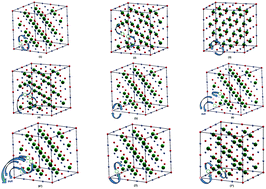当前位置:
X-MOL 学术
›
Phys. Chem. Chem. Phys.
›
论文详情
Our official English website, www.x-mol.net, welcomes your
feedback! (Note: you will need to create a separate account there.)
Composition conserving defects and their influence on the electronic properties of thermoelectric TiNiSn.
Physical Chemistry Chemical Physics ( IF 2.9 ) Pub Date : 2020-04-02 , DOI: 10.1039/d0cp00956c K Kirievsky 1 , D Fuks 1 , Y Gelbstein 1
Physical Chemistry Chemical Physics ( IF 2.9 ) Pub Date : 2020-04-02 , DOI: 10.1039/d0cp00956c K Kirievsky 1 , D Fuks 1 , Y Gelbstein 1
Affiliation

|
Formation of composition conserving defects is an inherent feature that appears in compounds for thermoelectric applications during the processes of their fabrication. Different types of such defects including exchange antisite defects, Schottky defects, and triple-, quatro- and penta-defects in TiNiSn are considered. Density functional theory calculations of the energy of formation of these defects are carried out. It is demonstrated that their formation may lead to a significant decrease of the band gap (Eg), simultaneously causing a transformation to p-type or semi-metal conductivity in this material. The role of nanopores is discussed. It is shown that preparing nanoporous compounds may be an efficient way to create p-type TiNiSn, simultaneously decreasing the thermal conductivity and improving its thermoelectric parameters.
中文翻译:

成分保留缺陷及其对热电TiNiSn电子性能的影响。
保留组成的缺陷是在其制造过程中出现在用于热电应用的化合物中的固有特征。考虑了不同类型的此类缺陷,包括交换反位缺陷,肖特基缺陷以及TiNiSn中的三重,四重和五重缺陷。进行了这些缺陷形成能量的密度泛函理论计算。已证明它们的形成可能导致带隙(Eg)的显着减小,同时导致该材料中的p型或半金属电导率转变。讨论了纳米孔的作用。结果表明,制备纳米多孔化合物可能是制备p型TiNiSn的有效方法,同时降低了热导率并改善了其热电参数。
更新日期:2020-04-15
中文翻译:

成分保留缺陷及其对热电TiNiSn电子性能的影响。
保留组成的缺陷是在其制造过程中出现在用于热电应用的化合物中的固有特征。考虑了不同类型的此类缺陷,包括交换反位缺陷,肖特基缺陷以及TiNiSn中的三重,四重和五重缺陷。进行了这些缺陷形成能量的密度泛函理论计算。已证明它们的形成可能导致带隙(Eg)的显着减小,同时导致该材料中的p型或半金属电导率转变。讨论了纳米孔的作用。结果表明,制备纳米多孔化合物可能是制备p型TiNiSn的有效方法,同时降低了热导率并改善了其热电参数。











































 京公网安备 11010802027423号
京公网安备 11010802027423号